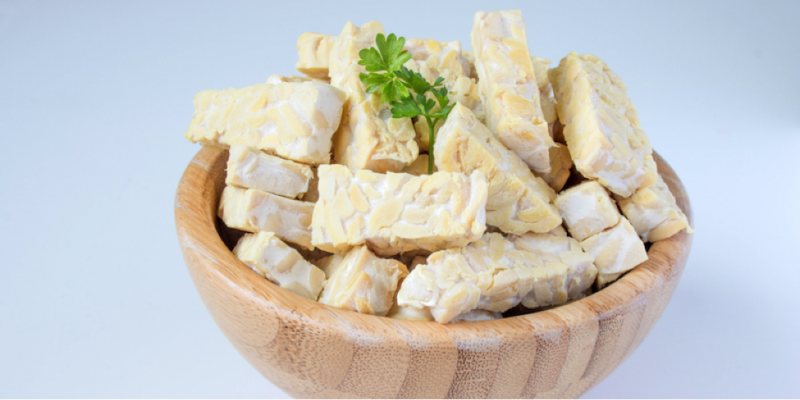Spotlight on Tempeh
Ever heard of Tempeh? You might have heard of it and thought it was one of those “weird/strange/different” foods but we want to take the mystery out of this special ingredient, putting a spotlight on tempeh and how you can get more of it in your diet.
But first things first, what is Tempeh?
- Fermented soy product – Tempeh comes in patty form. It’s made with the whole soybean with very little processing, unlike tofu which is very processed.
- Vegan protein – it’s high in protein, making it an excellent plant-based protein source. Use it to substitute meat in dishes as it has a flavour that’s a bit of a mix of mushroom and nuts.
Health Snapshot
There are a plethora of health benefits to be experienced when you make tempeh a part of your diet, here are just a few:
- Probiotics – Tempeh and other fermented foods lead to an increase of antibodies and a stronger immune system; plus, they regulate the appetite and reduce sugar and refined carb cravings. Probiotics found in tempeh, also break down sugars so they’re more easily digested, break down carbohydrates, control harmful bacteria in the body, fight diarrhoea, help with indigestion, fight chronic inflammation and boost immune system function.
- High in fibre – According to, one serving of tempeh contains more fibre than most people consume in a day. Fibre is essentials for a healthy digestive tract as well as prevent many chronic diseases.
- Ideal for people on low sodium diets. Unlike other fermented soy products, like miso which is very salty, tempeh is super low in sodium.
- Great for diabetic people. The protein in tempeh is excellent for diabetic patients, who tend to have problems with animal sources of protein. The protein and fiber in tempeh can also prevent high blood sugar levels and help in keeping blood sugar levels under control.
- High in protein. Add tempeh to your diet to boost your protein intake. Tempeh contains high-quality complete protein and provides all the amino acids you must obtain from your diet. Its protein content helps you maintain muscle tissue, and also make enzymes your cells need to function. Tempeh’s protein is as easily absorbed and utilised as protein from animal sources, such as eggs or meat, so it makes a particularly welcome addition to vegetarian and vegan diets.
Selection and Storing Tips
- Natural Stores. You can find Tempeh pre-packages in the refrigerated section of most natural stores. Make sure to check the label for the “use by” date. It should have one, and you should make sure that it’s up ahead in the calendar.
- Special Order. You might not find it in some mainstream groceries like you do tofu, but try asking and you may be surprised that they do stock it and can order more for you. If you have to order in bulk, that’s okay because it can be frozen until you want to use it.
- Go Organic. Select tempeh that’s made from organic soy to avoid GMO tempeh.
- Based on looks. Look for tempeh that is covered with a thick whitish bloom. While it may have a few black or greyish spots, there should be know pink, yellow or blue colouration as that indicated that it has become overly fermented. In general go for tempeh in which the soybeans and grains appear tightly bound. Also choose tempeh that has a drier outside surface.
- Freeze it. Uncooked tempeh can remain fresh in a freeze for several months. If you freeze tempeh and then unthaw it, you can keep the thawed tempeh in your refrigerator for about 10 days.
Cleaning, Prepping and Cooking Tempeh
There are two different types of tempeh. It is available either as:
- Fresh (or fresh frozen) –
- Vacuum-sealed/Pre-packaged Tempeh – these are usually ready-to-eat and usually don’t have to be pre-cooked. However, it’s advised to still cook the pre-packaged tempeh before using it in a recipe. This is because cooking it will help soften and moisten it, making it more easy to enjoy; and also allows the “patty” to be easier to mix flavours with it, which is especially helpful if you decide to marinade your tempeh.
Tempeh can be cut into slices or crumbled. Crumbled tempeh can be compared similar to ground meat it will shift into the background of the dish and feel much more like a texture-only component. Sliced tempeh usually serves as the “feature” ingredient of a dish. Both sliced and crushed tempeh can do a great job soaking in flavours and sauces.
Serving Ideas
- Make your spaghetti vegetarian and swap out ground beef for crumbled tempeh
- Add extra flavour, texture and nutrition to chilli by adding some tempeh
- Usually, tempeh is eaten cooked, it can be marinated, grilled, grated, stir-fried, pan-fried, toasted, baked or steamed.
- Have it in a sandwich.
- Marinate cubes of tempeh and lightly saute, to make a delicious substitute for ham or cheese in a salad.
